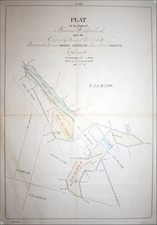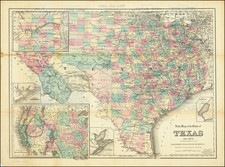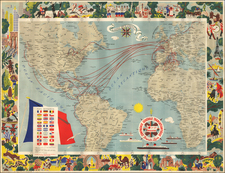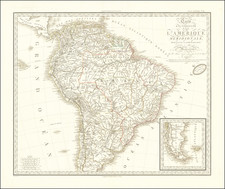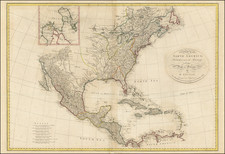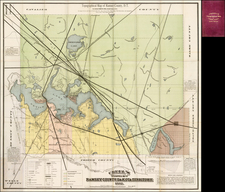First Appearance of Jedidiah Smith's Explorations and Travels in the West
Extremely Rare First State of Brue's map of North America, one of the most important early maps of the American West.
Brue's map of North America is a landmark map in North American history, including a number of early cartographic deails and some important firsts. Of greatest note, is the first map to incorporate information derived from Jedediah Smith. As noted by Wheat:
In 1833 the widow of A.H. Brue . . . supervised the publication in Paris of a monumental map of North America . . . on which a number of new items appeared. This map was primarily of the Lewis and Clark-Stephen H. Long type, but in the southwest the R. Timpanagos was declared to be the "Source principale du Multomah," a really new idea. The great southeastern branch of that river, connected with Lake Timpanagos by a dotted line, is labled R. Mackay," after one of the Hudson's Bay Company's traders, while the southern branch, or R. Calapaio, is stated to have its "Source pres de l'ocean." Roquefeuille de Morineau is declared the authority for the statement about the Sacramento River to the effect that it was navigable for fifty leagues "pour de grands bateaux."
That the tales of Jedediah Smith's journeyings had reached France is shown on this 1833 Brue map by "Mt. St. Joseph Couvert de Neige au mois de Mail," in what is now Nevada, where also occur the legends "Pays desert, aride et sablonneux, sans gibier et habite par quelques bands d'indiens," and "Pays peuple, en quelques endroits d'un grand nobre d'indiens, qui vivent de poissons et de graines." But what best evidences Smith is the dotted line of the river, near R. Ashley, called R. Adams at its head, which finally runs into the Colorado from the north near its mouth. For the most of its route this stream is a dotted line but it is labled the "Seeds of Keeder," Smith's name for the Green [River]. Smith's cave of salt is shown near it, and of the river the map states, "dont la source est inconnue elle renferme beaucoup de rapides." . . . the Rio de las "Pirami" des Sulfereas bears the most interesting note of all-- "Probablt. le Seeds Keeder de Smith." Here, then, is the first cartographic mention of the great explorer, by the same mapmaker who was to show his route to California a year later."
The first edition of the map was used and reproduced in part by the Alaskan Boundary Commission.
States of the Map and Rarity
Brue's map was first issued in 1833, with revised editions in 1840 and 1843 and 1845. Later editions are known to exist, but without the Jedidiah Smith information.
Brue's map is of the utmost rarity. We note the following census from OCLC:
- 1833 edition (Wurttembergische Landesbiblitherk, Bibliotheque Nationale De France)
- 1835 edition (Yale, Danish Royal Library)
- 1840 edition (UC Berkeley)
- 1843 edition (Osher Library, Texas Tech, see example offered by us in 2010 -- Princess Sissi copy)
- 1863 edition (British Library, Danish National Bibliothek)
- 1872 edition (Univerity of Chicago)
- 1874 edition (University of Chicago)
We note one auction record in the past 100 years listed by RBH (1835 edition) and no examples in dealer catalogs recorded by AMPR.
This is the first time we have seen the 1833 edition on the market.
Andre Hubert Brué was a French geographer and cartographer. Born in Paris, he served in the French Navy, joining the Baudin expedition to the Pacific (1800-1804). After his sea service, Brué applied his navigation and charting skills to creating finely-crafted maps, which were renowned for their crisp engraving and accuracy. He drew directly on the copper of the plate, creating what he called encyprotypes. He is best known for the Atlas universal de géographie physique, politique, ancienne et moderne.











